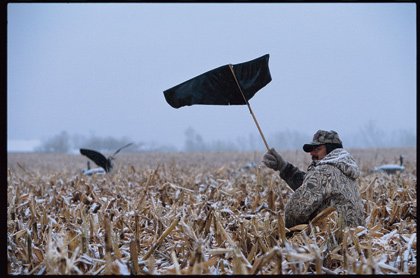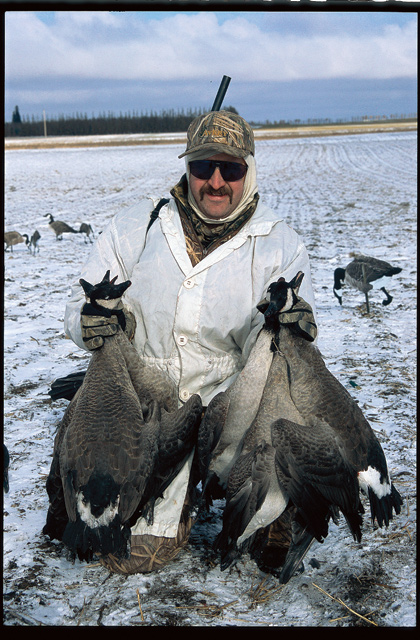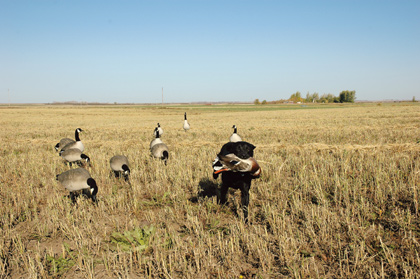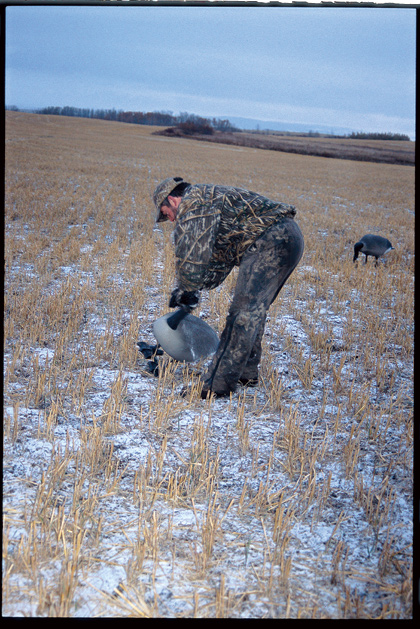November 03, 2010
By Michael Hungle
When Mother nature throws a meteorological curve, be prepared!
By Michael Hungle
 Photos by Bill Buckley. |
When heading afield for a waterfowl hunt, there are many variables such as where, when and how to hunt that I can control. However, there is one major variable that I simply have no control over. That variable is weather.
Advertisement
Since there is no changing the weather, I've learned to adapt my hunting styles and tactics to the conditions that Mother Nature throws my way. Weather conditions that I typically encounter throughout a season of waterfowling require different tactics for different situations.
Frost
There comes a time each hunting season, where the daytime temperatures are above the freezing mark, yet the night time temperatures plummet and dip below the freezing mark just prior to sunrise. When this happens, a blanket of frost generally starts to form on any and everything, including decoys.
Advertisement
As soon as the sun starts to rise and warm up the countryside, the frost will start to burn off causing decoys to get wet and glare. This unnatural glare is quickly spotted by keen eyed waterfowl causing them to flare.
After having the effects of frost spoiling lots of my hunts, I figured there had to be a way to overcome and successfully hunt on frosty mornings. At first, I tried downsizing my spreads and waiting until just before legal shooting time to set out my decoys. On some mornings, it seemed the decoys wouldn't frost up as much as if they were put out an hour earlier. However, this wasn't fool proof, because my decoys sporadically frosted up and I occasionally got caught short setting up decoys. Therefore, I kept searching for a better method.
In conjunction with setting out fewer decoys just at sunrise, I started keeping my decoys outside the night prior to a hunt. My reasoning was that instead of going from a warm garage or trailer directly into a cold field, the decoys would cool with the outside environment and not be as prone to frost. While this helped reduce the effects of frost, it seemed that frost would still form on my cool decoys.
Over the course of a morning, frost will eventually melt, turn to water on the decoys and then eventually dry. However, when birds are approaching and being turned away by shiny wet decoys, the burn off process doesn't happen fast enough. Thus, I started taking a handful of towels into the field and wiped down the backs and heads of decoys with the towels to help speed up the drying process.
 A good bunch of harsh weather Canadas. |
Finally, a couple years ago, I discovered fully flocked decoys. What impresses me the most about these decoys is that they don't frost up as much as regular decoys and even when they do frost up, they do not glare or shine when the frost starts to melt. Instead, the flocking absorbs the moisture and the decoys simply get a little darker.
Now when frost is in the forecast, I'll use a spread of fully flocked decoys. Since they don't frost up like painted decoys, I get set up early and don't hold back on the size of my decoy spread.
Fog
Over the years, I've encountered all kinds of foggy situations while hunting. However, I typically classify fog in two ways. Pea soup fog is heavy fog so thick you can barely see your own hand when you stick it out front of your face. This type of fog also seems to linger for long periods of time and can hang around well past mid morning. Ground fog is the wispy fog that forms at night when the temperatures drop rapidly. In most instances, ground fog isn't overly thick and usually burns off shortly after sunrise.
From my experiences, pea soup fog will suppress bird activity and keep them on their roosts until the fog burns off. In years past, I found these situations very frustrating because there was no bird activity. My patience level would quickly wear thin and within an hour after sunrise, I would have had enough. The entire spread would be packed up and my buddies and I would go home disappointed.
Several years ago on one such outing, the fog was so thick we didn't dare try to pack up and head for home. Instead, we settled into our blinds and waited for the fog to lift until we could see well enough to go home. At about 11 a.m., the fog started lifting enough that we figured we should start picking up of decoys. Within minutes, the fog completely disappeared and bright blue skies were around us. Thankfully, we hadn't picked up too many decoys as the distinct sounds of calling geese could be heard. Looking back toward the direction we anticipated the birds to come from, we saw flock after flock of geese coming at us. The few decoys we had packed up got set out haphazardly. We then jumped back into our blinds and were treated to some of the fastest goose hunting action of the season.
 When the weather breaks, birds pile in. |
Since that time, I've suddenly become much more patient when faced with pea soup fog. Instead of cursing and heading for home, I settle in and wait for the skies to clear. While doing so, my partners and I help pass the time by telling stories of past hunts, plan future hunts and tell jokes. It's a jovial time, because experience has shown that when the fog eventually lifts, the birds will come hard and fast, making for some memorable hunting action.
It seems that ground fog doesn't really impact waterfowl as much as pea soup fog and in most cases, the birds will leave their roosts and fly out to feed on their normal flight patterns. The only real difference is that ground level fog sometimes impacts their visibility as they fly out to feed and the birds can end up feeding in different locations.
When hunting under such conditions, I try to use as many decoys as I possibly can and spread them out much farther than normal to try and increase my odds of being seen by birds on the wing. In addition to bigger and wider decoy spreads, I try to call as loudly and aggressively as I can with hopes of attracting any birds that cannot see my spread. Over the past few years, this tactic has served me well when hunting waterfowl during ground fog conditions.
Wind
There's nothing worse than having the wind direction change in the middle of a hunt. When such an event hap
pened, it used to involve a great effort on my behalf to move decoys, relocate the landing zone and reposition blinds. After being caught in the open on one too many occasions and missing out on some prime shooting opportunities, I figured there had to be a better and quicker method to change things up when the wind suddenly changed directions.
After lots of experimenting with decoy spreads and blind placement, I discovered that an "X" pattern is my best decoy pattern option to use on hunts when there's the possibility of a wind change. In reality, my pattern is a "Fat X". The main body of this X contains my blinds and the bulk of my decoys. The intersecting lines of the X are formed by running strings of decoys to represent birds landing and walking up to the main spread and birds walking away from the main spread to spread out and feed. In most situations, I make each intersecting line of decoys 30 yards long, so that no matter which way I'm facing, I always know when birds are within shooting range.
 Snow on the backs of dekes...an ongoing problem for inclement weather waterfowlers. |
By setting up my decoys in this "Fat X" pattern, I actually create four potential landing zones and the potential for numerous quick variations of each landing zone depending on the wind direction. If the wind changes in a multiple of 90 degrees, all that's needed on my behalf is a simple repositioning of head positions on my walkers and quick shift of my blinds. If the wind shifts on a direction that's not a multiple of 90 degrees, all I need to do is reposition a line of walkers, change the head positions of the decoys in the other lines and spin the blinds.
When setting up the main body of my "Fat X", I deploy my decoys in a multitude of directions as opposed to having the bulk facing into the prevailing wind direction. By doing so, I never have to reposition any of those decoys when the wind changes and my switch over to the next landing zone is smooth and quick.
Before each hunt, I go to great efforts to watch the weather forecast to determine which direction the wind will blow from. If the forecast is for changing wind directions, I now go with my "Fat X" setup.
Snow
I generally find hunting in the snow a very rewarding experience. Unfortunately, I've also found that hunting in the snow can prove to be frustrating. Therefore, in order to turn the odds in my favor, I take a few extra precautions when hunting in snow covered fields that I wouldn't normally take when hunting in non-snow covered fields.
On days when the fields are covered in snow, I change the way I setup my decoys to reduce the effects of vehicle tire tracks around my spread. My general decoy set up routine prior to snow on the ground is to drive up to my hunting spot from the down wind side, shine the head lights of my truck onto the area where the decoys are to be set up and then proceed to set up from the downwind end and work forward into the wind. Once everything is set up, I back my rig out of the area and drive away.
When hunting a snow covered field, my set up routine changes. I approach the location of where I plan to set up my decoys from the upwind area and park my truck and decoy trailer a hundred or more yards upwind of where I plan to have the upwind edge of my decoy spread. From there, all the decoys and blinds are carried by hand into position. In addition, this is usually done under the cover of darkness or with flashlights as my vehicle is turned off as soon as it's stopped to prevent the heat from the motor melting the snow and revealing a non-natural area of exposed ground or melted snow.
When everything is unloaded and set up, I'll start up my truck and quickly drive away from the area and hide my vehicle. Upon returning to my spread, I'll use a rake to smooth out the snow and fill in the foot tracks that were made in the snow by walking back and forth while putting out decoys.
By going to this extra effort, approaching geese do not see vehicle tracks in the snow covered field as they approach the landing zone. In addition, they do not see a bunch of tell tail tracks of people walking around in the snow.
 A front closes in. |
It's no secret that decoys show up great on snow covered fields and are visible for long distances. However, the opposite is true when snow is falling. Snow can quickly cover the backs of the decoys, which makes them harder for ducks and geese to see. In addition, snow covered decoys look unnatural as snow never seems to accumulate on the backs and heads of feeding waterfowl.
If it starts snowing while I'm hunting, I continually get out of my blind and either knock or brush the snow off my decoys so they look natural. Over time, I've found that a vehicle window brush works great for removing snow off my decoys and can be easily tucked into a blind when not in use. When snow is in the forecast, I usually downsize my spread so that I have fewer decoys to clean off which reduces my odds of being caught in the open with a snow brush in my hands.
Another trick I like to use when hunting in snow is to deploy sleeper decoys and take the legs off some of my full body goose decoys. I do this to represent content relaxed birds that are spending the day feeding and resting in a stubble field.
When hunting in snow, I also try to eliminate any signs of blood stains in the snow from downed birds. To do so, I try to kick white snow over any blood stains I see when picking up downed birds. In addition, I also try to hide all downed birds in my blinds so that blood does not leech out and stain the snow.
Wind
When the wind is blowing, it's easy to set up a landing zone and position the blinds so that I have close range head on shots at birds attempting to land where I want them to. However, when the wind isn't blowing, the advantage goes to the birds as they seem to land haphazardly all around the spread and often approach the decoys from various directions.
Under these conditions, I tighten the main body of my decoy spread by spacing my decoys two to three feet apart to prevent ducks and geese from attempting to land within the main decoy spread. I also exaggerate my landing zone by making it wider and longer than normal. To add further appeal to my landing zone, I'll set up one to three decoys that represent birds that have just landed.
To further increase my odds of getting in some shooting opportunities, I'll position my blinds just off to one side or the other of my landing zone for angling and quartering shots as opposed to putting them in the main decoy spread for head on shooting opportunities. The side of t
he spread I pick to set my blinds up on these windless hunts is determined by the direction I anticipate the birds to come from. Essentially, I position the blinds so that I can see the birds coming at my spread as opposed to having them come in from behind and taking me off guard.
When hunting on windless days, I get away from trying to have picture perfect hunts and work the birds into position for classic feet down close range shooting opportunities. Instead, once the birds are within shooting range, I watch them and try to read their body actions. If it looks like the birds are going to keep on coming and get closer, I'll hold off on shooting. However, if it appears as if they are going to move out of shooting range, I'll call the shot instantly instead of trying to work them around for a closer shooting opportunity.
As you can see, I do things differently when hunting in different weather conditions. However I also monitor the outcome of each hunt and keep track of what works and what doesn't work in various weather conditions for fuure reference.

